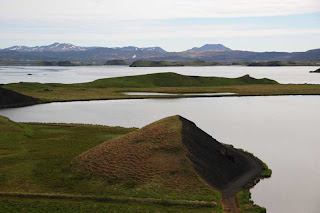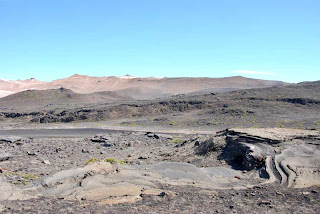Reykjavik, Iceland
It was 5.15 in the afternoon by the time we returned to the mainland after our excursion to Papey Island. The sun had come out, but there was still mist hanging around some of the hills as we drove around some of the Eastern Fjords.
One attractive town was Faskrudsfjordur. This used to be a base for French fishermen and the French built a hospital and a chapel there. All the street signs are in both French and Icelandic. The largest town on the largest fjord is Reydarfjordur. It was a large Allied base during World War II, and now it is the site of a large aluminium smelter.
From there we turned north, away from the coast, and drove along a steep river valley to Egilsstadir (#4 on the map).
Thursday morning we took a run out to Seydisfjordur, the terminal for the car ferry from Denmark. The road runs across a high snow covered plain and then steeply winds down into the town. The ferry had just arrived and it was quite a change to meet so much oncoming traffic. I felt sorry for the cyclists just starting their tour of Iceland - quite a strenuous climb, but the scenery is spectacular.
The town itself is in a lovely natural setting at the head of the fjord and surrounded by snow capped mountains. Many of the attractive wooden houses date from the nineteenth century when the herring industry was important.
Our next destination was Saenautasel, a small turf farmhouse which was used as a homestead from 1843 until 1943, except for the period 1875-1880 when ash from the Askja eruption made the area uninhabitable. The area roundabout is a high desolate heath and life would have been a struggle so it is probably not surprising that after the 1875 eruption, many of the farmers fled to America.
The Jokulsargilufur Canyons National Park is near here. As you enter the park, the road sign warns - 48 km of bad gravel and the first few kilometres were pretty awful horrugations, but it can't have been so bad, because when we got to Dettfoss there were 3 tour buses ( the cause of the corrugations) parked there! Dettfoss waterfall has an enormous volume of water, but it is dirty gray and not very pretty. Further along we came to Asbyrgi, a strange horse shoe canyon and within its sheltering walls a birch forest thrives - such a contrast to the desolate heath we drove over earlier in the day.
Friday we spent around Lake Myvatn exploring the sputtering mudpots, steaming fumeroles, strange lava formations, craters and pseudo craters and I have included a few photos below. Friday night we stayed in a much larger Edda Hotel in Akureyri - Iceland's second biggest town. (#6 on the map). Edda hotels operate in summer using buildings which function as boarding schools during winter. The town even runs to a pedestrian mall where I bought myself an Icelandic souvenir - a handknitted sweater.
We were glad the supermarket was open and we were able to buy ourselves a low alcohol beer as the day had been surprisingly warm - over 20 C.. Beer was illegal in Iceland until 1989. Apart from low alcohol beer, all alcohol can only be bought in government liquor shops and in some towns the hours are extremely restrictive, e.g. between 5 and 6 p.m. Monday to Friday and between 4 and 6 p.m. on Saturday in Djupivogur!
On Saturday we had a long drive back to Reykjavik, but still made three stops. the first was to a horse farm where my niece had helped with the autumn muster about 5 years ago. Evelyn welcomed us and showed us some of her 150 horses.
Iceland, like Australia has very strict quarantine rules. If a horse is sent abroad, it can never return to Iceland. Just recently there has been an outbreak of what maybe equine flu and the owners and breeders were very worried. The big biennial horse show was cancelled. The suspicion is that the virus arrived on equipment from the USA.
Our next stop was at the stone church at Thingeyrar. This church was built between 1864 and 1877, but there has been a church and/or Benedictine monastery on the site since at least 1112. It took five years to haul the stone to the site, by dragging it across the ice in winter and then several more years to import the lime mortar from Denmark. The ceiling has 1000 gold stars painted on it.
Last stop was the excellent Settlement museum in Borganes. The English audio guide explains a lot about the original Viking settlement. Models of the longboats show how the livestock and people were transported on the 3 or 4 day voyage.
It is estimated that by the time the first parliament was held in 930 A.D. (I should say C.E. as the Icelandic parliament did not vote to become Christian until 1000 A.D.) there would have been a population of more than 30,000.
We returned a very dusty car to Hertz at 6 p.m. which meant we avoided the necessity of finding a parking place - not easy in central Reykjavik!
On Sunday we began the long trek home, via Amsterdam, Dubai and Kuala Lumpur.
I could not resist another puffin photo.
Our boat at the landing on Papey Island. The puffins nest along the top of the cliff near the landing.
Moss campion on Papey Island
The little private church on Papey Island.
Typical late afternoon along the Eastern Fjords
Seydisfjordur, where the Danish car ferry docks.
One of the Norwegian style 19th C houses in Seydisfjordur.
Pastoral scene.
Driftwood gable end of a turfhouse at Laufas
Early 20th C kitchen utensils in the turf house at Laufas
I was intrigued by the small beds in the turf houses. This cot could be expanded lengthwise.
and the width of this bed could be expanded.
Pseudo craters at Skutustadargigar
Another lava field and lake in the Lake Myvatn area.
Lunar landscape near Lake Myvatn
Mud pot gurgling - a bit hard to catch on camera!
Myvatn Geothermal Baths. Swimming is very popular in Iceland. Apart from natural hot springs, the abundance of geothermal heat is used to provide public swimming pools and saunas, spas in most towns.
The midges are thick around Lake Myvatn. They do not bite and although annoying are not as irritating as Australian bush flies, so the head nets looked overkill!
Godfoss - waterfall of the Gods
A 14th C alabaster altarpiece in the Thingeyrar church. This was made in Nottingham. I am always fascinated by the extent of trade in Medieval and earlier times.
One of Evelyn's Icelandic horses
Whooper swans breed in Iceland
This street sculpture in Reykjavik appealed to me.
Both menus are about A$55 so I don't think they will be big sellers.
I have tried to record our holiday in an interesting and informative way and hope you have enjoyed reading it. This blog is now going into hibernation, but hopefully in a few months we will be able to make another trip somewhere and I will reactivate it.

























Thanks so much for your blog, Kate. It is always interesting, informative, and beautiful to look at!
ReplyDeleteKate, many thanks for your fabulous writing/photography of your travels. Spectacular scenery in Iceland, I had no idea that it was like that. Safe travels home. See you soon
ReplyDeleteCheers Jenni
Papey is such a beautiful little island. The boat ride over is also great. Here is a full list of all the ferries in Iceland!
ReplyDeletehttp://www.rent.is/blog/ferries-in-iceland/
Happy sailing!